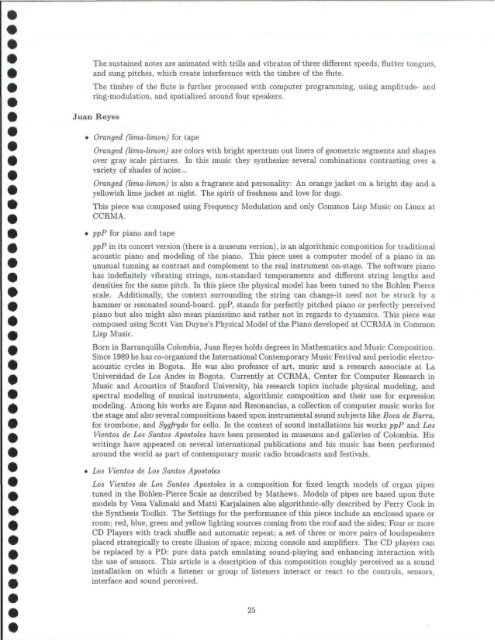CCRMA OVERVIEW - CCRMA - Stanford University
CCRMA OVERVIEW - CCRMA - Stanford University
CCRMA OVERVIEW - CCRMA - Stanford University
You also want an ePaper? Increase the reach of your titles
YUMPU automatically turns print PDFs into web optimized ePapers that Google loves.
The sustained notes are animated with trills and vibratos of three different speeds, flutter tongues,<br />
and sung pitches, which create interference with the timbre of the flute.<br />
The timbre of the flute is further processed with computer programming, using amplitude- and<br />
ring-modulation, and spatialized around four speakers.<br />
Juan Reyes<br />
• Oranged (lima-limon) for tape<br />
Oranged (lima-limon) are colors with bright spectrum out liners of geometric segments and shapes<br />
over gray scale pictures. In this music they synthesize several combinations contrasting over a<br />
variety of shades of noise...<br />
Oranged (lima-limon) is also a fragrance and personality: An orange jacket on a bright day and a<br />
yellowish lime jacket at night. The spirit of freshness and love for dogs.<br />
This piece was composed using Frequency Modulation and only Common Lisp Music on Linux at<br />
<strong>CCRMA</strong>.<br />
• ppP for piano and tape<br />
ppP in its concert version (there is a museum version), is an algorithmic composition for traditional<br />
acoustic piano and modeling of the piano. This piece uses a computer model of a piano in an<br />
unusual tunning as contrast and complement to the real instrument on-stage. The software piano<br />
has indefinitely vibrating strings, non-standard temperaments and different string lengths and<br />
densities for the same pitch. In this piece the physical model has been tuned to the Bohlen Pierce<br />
scale. Additionally, the context surrounding the string can change-it need not be struck by a<br />
hammer or resonated sound-board. ppP, stands for perfectly pitched piano or perfectly perceived<br />
piano but also might also mean pianissimo and rather not in regards to dynamics. This piece was<br />
composed using Scott Van Duyne's Physical Model of the Piano developed at <strong>CCRMA</strong> in Common<br />
Lisp Music.<br />
Born in Barranquilla Colombia, Juan Reyes holds degrees in Mathematics and Music Composition.<br />
Since 1989 he has co-organized the International Contemporary Music Festival and periodic electroacoustic<br />
cycles in Bogota. He was also professor of art, music and a research associate at La<br />
Universidad de Los Andes in Bogota. Currently at <strong>CCRMA</strong>, Center for Computer Research in<br />
Music and Acoustics of <strong>Stanford</strong> <strong>University</strong>, his research topics include physical modeling, and<br />
spectral modeling of musical instruments, algorithmic composition and their use for expression<br />
modeling. Among his works are Equus and Resonancias, a collection of computer music works for<br />
the stage and also several compositions based upon instrumental sound subjects like Boca de Barra,<br />
for trombone, and Sygfrydo for cello. In the context of sound installations his works ppP and Los<br />
Vientos de Los Santos Apostoles have been presented in museums and galleries of Colombia. His<br />
writings have appeared on several international publications and his music has been performed<br />
around the world as part of contemporary music radio broadcasts and festivals.<br />
• Los Vientos de Los Santos Apostoles<br />
Los Vientos de Los Santos Apostoles is a composition for fixed length models of organ pipes<br />
tuned in the Bohlen-Pierce Scale as described by Mathews. Models of pipes are based upon flute<br />
models by Vesa Valimaki and Matti Karjalainen also algorithmic-ally described by Perry Cook in<br />
the Synthesis Toolkit. The Settings for the performance of this piece include an enclosed space or<br />
room; red, blue, green and yellow lighting sources coming from the roof and the sides; Four or more<br />
CD Players with track shuffle and automatic repeat; a set of three or more pairs of loudspeakers<br />
placed strategically to create illusion of space; mixing console and amplifiers. The CD players can<br />
be replaced by a PD: pure data patch emulating sound-playing and enhancing interaction with<br />
the use of sensors. This article is a description of this composition roughly perceived as a sound<br />
installation on which a listener or group of listeners interact or react to the controls, sensors,<br />
interface and sound perceived.<br />
25

















